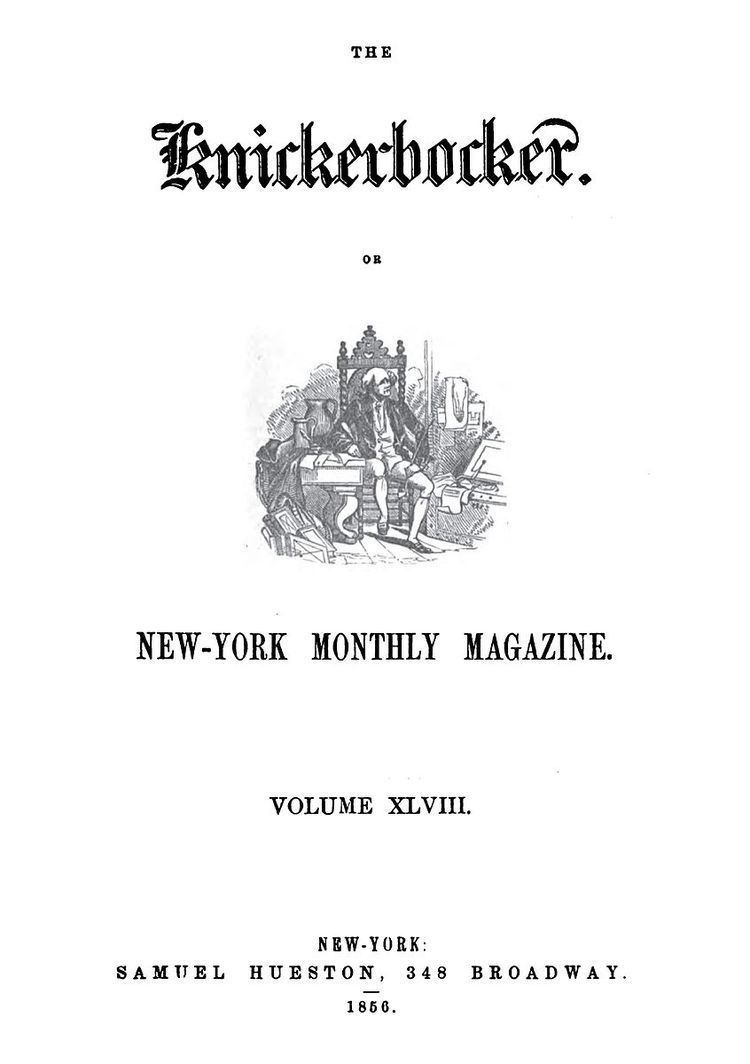Frequency Monthly Year founded 1833 | ||
 | ||
Staff writers | ||
The Knickerbocker, or New-York Monthly Magazine, was a literary magazine of New York City, founded by Charles Fenno Hoffman in 1833, and published until 1865. Its long-term editor and publisher was Lewis Gaylord Clark, whose "Editor's Table" column was a staple of the magazine.
Contents
The circle of writers who contributed to the magazine and populated its cultural milieu are often known as the "Knickerbocker writers" or the "Knickerbocker Group". The group included such authors as William Cullen Bryant, Henry Wadsworth Longfellow, Oliver Wendell Holmes, James Russell Lowell and many others.
The Knickerbocker was devoted to the fine arts in particular with occasional news, editorials and a few full-length biographical sketches. The magazine was one of the earliest literary vehicles for communication about the United States' "vanishing wilderness." As such, The Knickerbocker may be considered one of the earliest proto-environmental magazines in the United States.
History
Charles Fenno Hoffman was the founding editor of The Knickerbocker in 1833, though he helmed only three issues. Lewis Gaylord Clark bought the magazine in April 1834 and served as editor until 1861. By 1840, The Knickerbocker was the most influential literary publication of its time. The year before, Washington Irving had reluctantly joined the staff at a salary of $2,000 a year and would stay on staff until 1841. Irving disliked magazine work, specifically because of its monthly deadlines and space constraints. However, in his "Geoffrey Crayon" persona, he justified his choice in his debut issue: "I am tired... of writing volumes... there is too much preparation, arrangement, and parade... I have thought, therefore, of securing to myself a snug corner in some periodical work, where I might, as it were, loll at my ease in my elbow chair."
The circle of writers who contributed to the magazine and populated its cultural milieu are often known as the "Knickerbocker writers" or the "Knickerbocker Group". The group included such authors as William Cullen Bryant, James Kirke Paulding, Gulian Crommelin Verplanck, Fitz-Greene Halleck, Joseph Rodman Drake, Robert Charles Sands, Lydia M. Child, Nathaniel Parker Willis, and Epes Sargent. Other writers associated with the group include Henry Wadsworth Longfellow, Oliver Wendell Holmes, James Russell Lowell, Bayard Taylor, George William Curtis, Richard Henry Stoddard, Elizabeth Clementine Stedman, John Greenleaf Whittier, Horace Greeley, James Fenimore Cooper, Fitz Hugh Ludlow and Frederick Swartwout Cozzens. The Knickerbocker was one of the earliest publications of its type to pay its contributing writers.
Name
The magazine was published under various titles, including:
At the time, "Knickerbocker" was a term for Manhattan's aristocracy.
Knickerbocker was also an imaginary personage created by Washington Irving to promote his new book at the time, A History of New-York from the Beginning of the World to the End of the Dutch Dynasty. The work was a satire of both history books and the politics of the time. Irving published the work in 1809 under the pseudonym "Diedrich Knickerbocker." Prior to the release of his book though, Irving placed a series of missing person adverts in New York newspapers concerning Diedrich Knickerbocker, convincing the public that he was a legitimate historian. However, though people soon realized it was a hoax, Diedrich Knickerbocker became a much-loved character and legend for those of the city of New York. He is also the namesake of the New York basketball team, The Knicks.
Knickerbacker Magazine was started in January 1833 with its first issue containing a supposed conversation with Diedrich Knickerbocker. In the interview he “readily forgave the liberty taken with his name in consideration of our having restored it to its ancient spelling.” This refers to the change from Knickerbocker to Knickerbacker. However, the second issue was published with the title changed to Knickerbocker including another conversation with Diedrich Knickerbocker in which he says "I wish thee to restore my name to its original spelling as it stands in my celebrated History; so as fortune has given immortal glory to what some would consider a discreditable mistake I will even take it as it came and add the 'O' to the end of time."
Content
The Knickerbocker was devoted to the fine arts in particular with occasional news and editorials. Full-length biographical sketches were also printed on such artists as Gilbert Stuart, Hiram Powers, Horatio Greenough, and Frederick Styles Agate.
According to environmental historian, Roderick Nash, The Knickerbocker was one of the earliest literary vehicles for communication about the United States' "vanishing wilderness", including serialized articles by Thomas Cole and Francis Parkman, Jr. As such, The Knickerbocker may be considered one of the earliest proto-environmental magazines in the United States. The Knickerbocker printed the earliest-known reference to the joke "Why did the chicken cross the road?"
In the early 1800s, the Reverend Edward Hitchcock came across a set of what appeared to him to be giant bird tracks. These later turned out to be reptile tracks, however they nonetheless inspired him to write a poem entitled "The Sandstone Bird" involving the reanimation of a great sandstone bird by a female mystic. Later published in The Knickerbocker by Hitchcock, under the pseudonym Poetaster, this is widely believed to have been the first ichnological poem.
Environmental impact
Eric Kaufman, a professor of politics commented in his paper on "American Naturalistic Nationalism" that the "naturalistic aesthetic first took root among writers in New England and New York. These intellectuals, connected by New York literary periodicals like Knickerbocker Magazine ... responded in several ways to the new naturalistic sensibility" the influence of which can be seen in many of their published works.
Some famous works first published in The Knickerbocker that have influenced environmental thought include:
